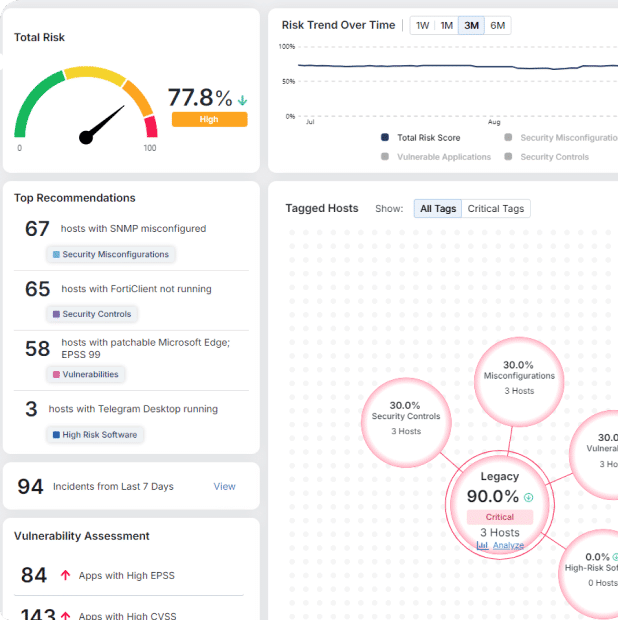Cybersecurity Resilience in Healthcare: Prescribing a Stronger Defense

In today’s digitally driven healthcare landscape, cyber threats are not just a technical challenge—they are a significant risk to patient safety, organizational reputation, and regulatory compliance. Cybercriminals are relentlessly targeting healthcare organizations, exploiting vulnerabilities in systems, medical devices, and human error to gain unauthorized access to sensitive patient data, disrupt operations, and even compromise life-critical medical devices.
With attacks like ransomware, phishing, and advanced persistent threats (APTs) becoming more sophisticated, healthcare organizations need to move beyond reactive cybersecurity measures and adopt a proactive, resilience-focused defense strategy. This blog, brought to you by Omega Systems and Morphisec, explores the critical need for cybersecurity resilience in healthcare and provides actionable insights on how to build a robust and adaptive defense infrastructure.
Why Cybersecurity Resilience Is Critical for Healthcare
Healthcare organizations are unique in their cybersecurity challenges. Unlike other industries, healthcare faces a dual responsibility: protecting patient data while ensuring uninterrupted access to life-critical systems. Here’s why resilience is no longer an option but a necessity:
1. Rising Threat of Ransomware Attacks
Ransomware attacks on healthcare organizations have surged, with attackers targeting electronic health records (EHRs), medical devices, and administrative systems. These attacks often result in significant downtime, delayed patient care, and ransom payments that further fund cybercriminal activity.
Case in Point: In 2021, the ransomware attack on the Irish Health Service Executive disrupted healthcare services nationwide for weeks, delaying treatments and surgeries. This incident highlights the devastating impact ransomware can have on healthcare delivery.
2. Vulnerabilities in Medical Devices
The Internet of Medical Things (IoMT) and the radical evolution of connected medical devices has revolutionized patient care, but it has also introduced new attack surfaces. Many medical devices run on outdated software and lack robust security controls, making them prime targets for hackers. A compromised device not only endangers patient safety but can also serve as a gateway for attackers to access the broader network.
3. Regulatory Compliance and Financial Penalties
Healthcare organizations are bound by stringent regulations such as HIPAA, HITECH, and GDPR, which mandate the protection of patient data. Non-compliance due to a breach can result in hefty fines, legal action, and irreparable reputational damage.
4. Evolving Cyber Threats
Cyberattacks are becoming more sophisticated, leveraging zero-day vulnerabilities, fileless malware, and social engineering tactics that traditional security solutions cannot detect. Healthcare organizations must stay ahead of these threats with advanced, adaptive security solutions.
Building Cybersecurity Resilience: A Proactive Approach
Achieving cybersecurity resilience in healthcare requires a multi-layered approach that combines cutting-edge technology, employee training, and strategic planning. Here’s how healthcare organizations can “prescribe” a stronger defense:
1. Embrace Proactive Threat Prevention
Reactive security measures are no longer sufficient to combat today’s advanced threats. Healthcare organizations need to adopt proactive solutions that prevent attacks before they occur.
Morphisec’s Role in Proactive Security
Morphisec’s Automated Moving Target Defense (AMTD) technology is a game-changer in proactive cybersecurity. By dynamically morphing the runtime memory of systems, AMTD prevents attackers from exploiting vulnerabilities, rendering ransomware and zero-day attacks ineffective.
Key Benefit: Morphisec’s solutions stop attacks in memory before they execute, providing a critical layer of defense that traditional EDR and NGAV solutions often miss.
2. Strengthen Endpoint Security
Endpoints are often the weakest link in any organization’s security posture. Healthcare environments, with their reliance on interconnected devices, are particularly vulnerable.
Omega Systems’ Managed Endpoint Detection and Response (EDR)
Omega’s EDR solutions provide continuous monitoring, threat detection, and automated response for endpoints, ensuring that any suspicious activity is quickly neutralized.
Key Benefit: With proactive threat hunting and one-click remediation and rollback, Omega’s EDR services protect healthcare organizations against endpoint-based attacks, including phishing and malware.
By integrating Morphisec’s AMTD with Omega’s EDR solutions, healthcare providers gain a comprehensive endpoint security strategy that stops advanced threats while reducing false positives and investigation times.
3. Prioritize Medical Device Security
Medical device security is a unique challenge due to the diversity and criticality they impose in healthcare networks.
Practical Steps to Secure Medical Devices
- Inventory and Segment: Identify all medical devices on the network and segment them into isolated networks to limit lateral movement.
- Regular Patching: Work with device manufacturers to ensure timely software and firmware updates.
- Medical Device Protection from Morphisec: Morphisec’s solutions protect vulnerable medical devices by preventing runtime memory exploitation, ensuring devices remain secure without requiring constant updates.
4. Ensure Robust Backup and Disaster Recovery
A resilient backup and disaster recovery strategy is critical to minimizing downtime and data loss during a cyberattack.
Omega Systems’ Backup & Disaster Recovery Solutions
Omega offers encrypted backup and disaster recovery services designed to ensure rapid restoration of operations in the event of an attack.
Key Benefit: Immutable backups prevent ransomware from encrypting or deleting backup files, ensuring healthcare organizations can recover quickly without paying a ransom.
5. Train Your Human Firewall
Cybersecurity is not just a technology problem—it’s also a human problem. Phishing and social engineering attacks target employees, making cybersecurity awareness training essential.
Omega’s Cyber Awareness Training
Omega’s training programs educate employees on recognizing phishing attempts, safe online behaviors, and the importance of following security protocols.
Key Benefit: A well-trained workforce reduces the likelihood of successful phishing attacks and other human-error-related breaches.
6. Adopt a Zero-Trust Security Model
Zero-trust security operates on the principle of “never trust, always verify,” ensuring that every user and device is continuously authenticated and authorized.
Omega and Morphisec’s Zero-Trust Solutions
- Omega’s Managed Cybersecurity Services: Implement access controls, identity verification, and continuous monitoring to enforce zero-trust principles.
- Morphisec’s Zero-Trust Alignment: Morphisec’s AMTD fits seamlessly into zero-trust architectures by blocking unauthorized access and preventing credential theft.
7. Monitor and Respond in Real-Time
Real-time monitoring and rapid incident response are essential to containing cyberattacks before they escalate.
Omega Systems’ Managed Detection and Response (MDR)
Omega’s MDR services provide 24x7x365 monitoring, advanced threat detection, and incident response, ensuring that threats are neutralized as soon as they are detected.
Morphisec’s Incident Prevention
Morphisec prevents attacks at the earliest stages, reducing the need for time-consuming investigations and manual responses.
Omega Systems and Morphisec – The Right Prescription
Together, Omega Systems and Morphisec offer healthcare organizations a comprehensive cybersecurity solution that combines:
- Proactive Prevention: Morphisec’s AMTD technology stops advanced threats before they execute.
- Continuous Monitoring: Omega’s MDR and EDR solutions provide 24×7 visibility and threat response.
- Resilient Recovery: Omega’s Backup & Disaster Recovery Services ensure rapid restoration of operations.
- Streamlined Compliance: Both companies’ solutions are designed to meet stringent healthcare regulations such as HIPAA and HITECH.
- Cost Efficiency: By reducing false positives and automating threat prevention, healthcare organizations can lower operational costs and improve resource efficiency.
Real-World Success Stories
Houston Eye Associates
Houston Eye Associates, a large healthcare organization, partnered with Morphisec to prevent ransomware attacks while reducing investigation costs by 65%. With Morphisec’s AMTD, they stopped multiple advanced threats in memory before they caused any damage, significantly enhancing their security posture.
Citizens Medical Center
Citizens Medical Center leveraged Omega Systems’ managed IT services to secure their IT infrastructure, implement robust disaster recovery plans, and achieve compliance with healthcare regulations. The result? Improved patient data protection and uninterrupted operations during cyber incidents.
Get Stronger Defense
Healthcare organizations cannot afford to take cybersecurity lightly. The stakes are too high—patient safety, data integrity, and organizational reputation are all on the line. By adopting a proactive, resilience-focused approach, healthcare providers can not only prevent cyberattacks but also ensure operational continuity and compliance with regulatory standards.
Omega Systems and Morphisec are committed to empowering healthcare organizations with the tools, expertise, and technologies they need to build a stronger defense against today’s evolving cyber threats. With solutions that are proactive, adaptive, and cost-efficient, we help healthcare providers focus on what matters most: delivering exceptional patient care.
Learn more and get started today:
- Join Our Webinar: Dive deeper into cybersecurity resilience strategies by attending our webinar on Tuesday April 1st at 1pm ET, Cyber Resilience in Healthcare: Prescribing a Stronger Defense.
- Download the Checklist: Use our comprehensive cybersecurity hygiene checklist to assess and improve your organization’s defenses.
- Partner with Us: Explore how Omega Systems and Morphisec can fortify your IT environment against cyber threats.
Together, let’s prescribe a stronger defense for healthcare cybersecurity. Reach out to learn how you can get started with Omega Systems and Morphisec.
Stay up-to-date
Get the latest resources, news, and threat research delivered to your inbox.



















